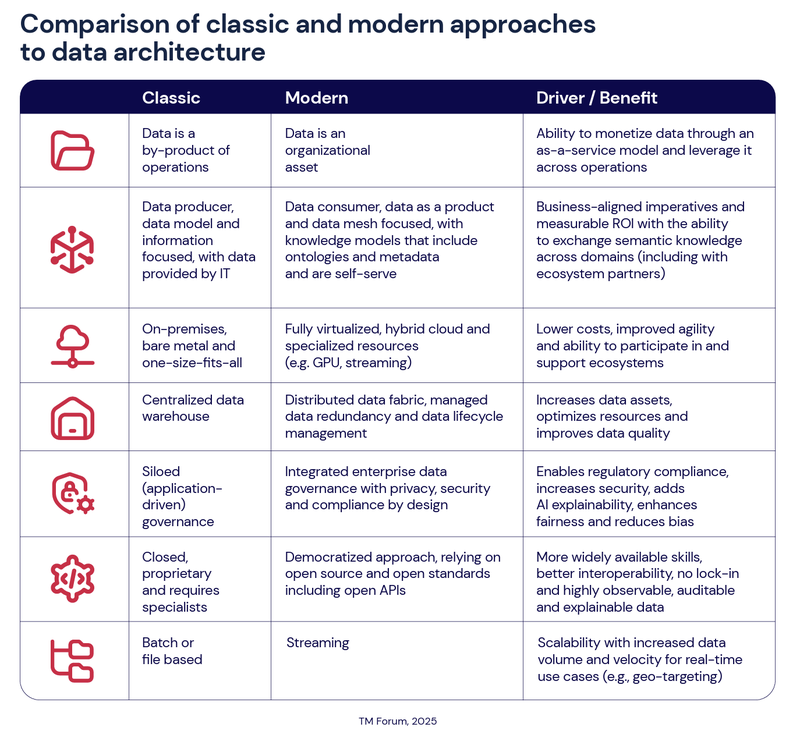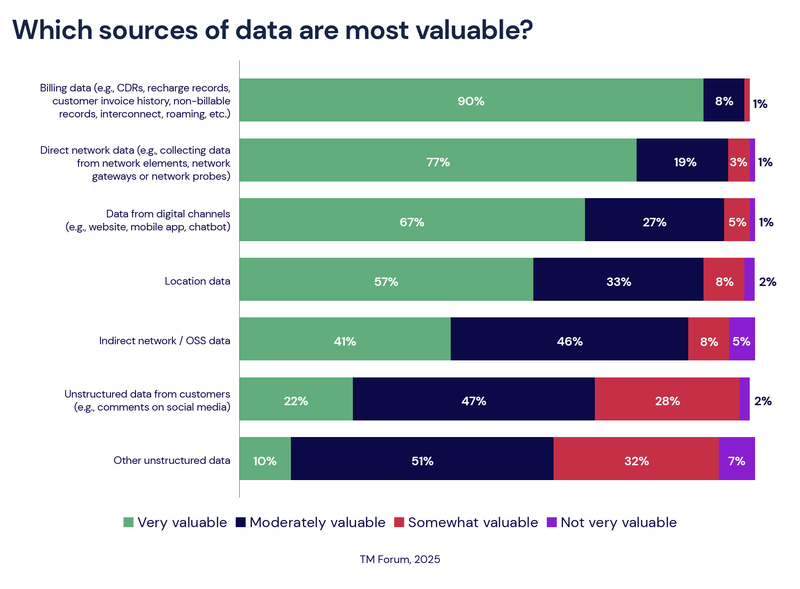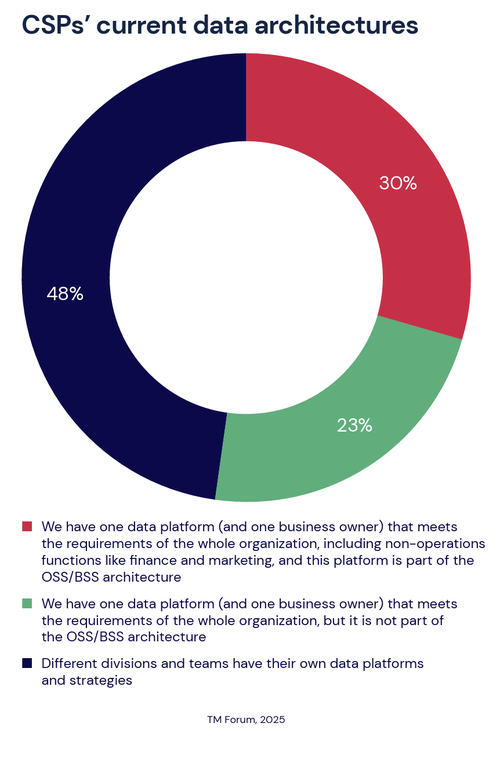In a recent survey by TM Forum nearly half of the respondents, most of whom are IT and network leaders, said their overall data strategy and architectures still follow a legacy approach. So what needs to change and where?

What needs to change in telco data architecture?
Legacy and modern data architectures differ fundamentally in the way they are designed. Legacy architectures comprise monolithic, centralized systems, with data stored in siloed databases tied to specific applications. Modern architectures are usually cloud native (though data may reside in private or sovereign clouds rather than the public cloud), and they leverage distributed systems.
In its approach to helping CSPs modernize their data architectures, TM Forum’s Data Architecture Project focuses on three key perspectives as outlined in the team’s introductory whitepaper:
“In modern data architectures we need to cater to both human data consumers as well as to data consumers that are ‘machines’,” the group explains.
“In general, the governance of the [modern data architecture] is similarly both extensive and complex, introducing new elements such as data observability and AI explainability, each of which requires a comprehensive view of the architecture.” The table on page 22, which is drawn from the Data Architecture group’s whitepaper, explains the differences between traditional and modern approaches to data architecture. The team has also produced a technical report called Data Architecture for AI-Enabled Telco (TR319), which outlines what a reference architecture looks like.
The table below, which is drawn from the Data Architecture group’s whitepaper, explains the differences between traditional and modern approaches to data architecture. The team has also produced a technical report called Data Architecture for AI-Enabled Telco (TR319), which outlines what a reference architecture looks like.

We surveyed 87 specialists at CSPs worldwide, most of which are senior IT and network executives. When asked which data is the most valuable, their responses demonstrated that customer data is most important by far, followed by direct network data. (see bar chart below). As one respondent wrote in their follow-up explanation: “We take anything said by the customer really seriously.”

Most CSPs have been transforming customer data for years, moving it to the cloud. But network data is a different story. It is still heavily siloed in legacy systems. “Network data is very fragmented and sometimes very proprietary, and the quality is not very good,” says Yannick Martel, VP of AI & Analytics at Capgemini.
“People are starting to think about modernizing the infrastructure and doing exactly the same movement now of network data that they have done for customer data… For network data, we are just starting.”

When we asked the 87 respondents to our survey about their current approaches to data architecture, nearly half said their overall data strategy and architectures still follow a legacy approach, where different divisions and teams have their own platforms. Nearly a third have one data platform for the entire organization as part of OSS/ BSS architecture, while about a quarter have one data platform that is not part of OSS/BSS (see pie chart on the next page). We intended for the answer choices to include the network. However, not all respondents read the question that way. “Option 1 considers non-network scope. The use of data in an operational sense at a network level is not reporting of information and requires an understanding of the information and appropriate knowledge,” a principal network architect responded.
Indeed, modernizing how network data is collected, stored and analyzed is challenging because the legacy approach of managing devices creates silos of data with no context for how the data in one silo is related to the data in another. The linkage historically has been provided by humans, but now the aim is to get humans out of the loop.
“If you want to take the humans out of the picture, then things have got to change somewhere in terms of how do you replicate [achieving that context] with far less humans?” the network architect said in a follow-up interview. “How do I get observability of what the network is doing at any point in time?… It’s a fundamental shift from where telcos have been previously.”

In our survey we asked who is responsible for data architecture within CSP organizations because this also helps to gauge how far along companies are in modernizing their approaches. Only 19% of respondents highlighted a leadership role focusing specifically on data (for example, Chief Data Officer, Chief Data & AI Officer or Chief Digital Officer).
“In the most advanced CSPs you’re starting to see true CDOs, people that really understand data, who are pushing the CTOs and the CIOs for technology stacks that can enable data in a democratic way,” says Ricardo Velhuco, Head of Cognitive Engineering at Nokia. “On the other hand, in the least advanced [companies] you have leadership mostly around operations, because that’s where a lot of the money is.” CIOs (or in some cases COOs) and CTOs are the ones “suffering the pain” of high operating costs, he explains.
At Orange responsibility for data strategy and architecture is distributed between the CTO function and a division that focuses specifically on data and AI, but these teams work closely with each other. Network and OSS data is overseen by group CTO Laurent Leboucher, while overall data and AI transformation is the remit of Chief AI Officer Steve Jarrett, with data and AI initiatives often co-sponsored by both.
This kind of collaboration may be an exception rather than the rule, however. In his work with telcos, Capgemini’s Martel typically sees a stark division between teams responsible for data, with network data managed separately. “Network data is very protected, very specific, very different, and [telcos] are really two companies in one in many cases,” he explains. “The CTO is embarking upon an autonomous network program and is dealing with this data.”
Whoever is in charge of data strategy and architecture must work closely with other leaders in the business such as the chief security officer, whose team is usually responsible for data governance.